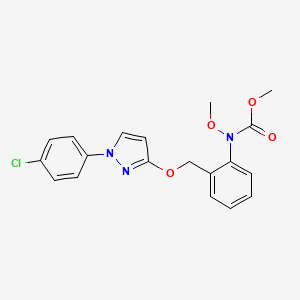D1073 | pyraclostrobin
| Toxicity | Dose | Time | Species | Model | Method | Action | Positive criterion | Reference |
|---|---|---|---|---|---|---|---|---|
| MEMBRANE POTENTIAL | 6.35±1.92 | human | qHTS-HepG2 | MMP assay | decrease | IC50 | 163 | |
| MEMBRANE POTENTIAL | 1.26 | human | HepG2 | MMP assay | decrease | IC50 | 163 | |
| MEMBRANE POTENTIAL | 9.04±1.89 | rat | hepatocytes | MMP assay | decrease | IC50 | 163 | |
| GLUCOSE GALACTOSE IC50 RATIO | 50µM | permeabilized LUHMES cells | Assessment of the function of individual mitochondrial complexes using Agilent Seahorse XFe24 | 326 | ||||
| Target | Dose | Time | Species | Model | Method | Action | Positive criterion | Reference |
|---|---|---|---|---|---|---|---|---|
| Quinol--cytochrome-c reductase | 50µM | permeabilized LUHMES cells | Assessment of the function of individual mitochondrial complexes using Agilent Seahorse XFe24 | inhibit | 326 | |||
| Pictogram | Signal | Statements | Precautionary Statement Codes |
|---|---|---|---|
   |
Danger |
Aggregated GHS information provided by 338 companies from 7 notifications to the ECHA C&L Inventory. Each notification may be associated with multiple companies. H315 (99.11%): Causes skin irritation [Warning Skin corrosion/irritation] H331 (99.11%): Toxic if inhaled [Danger Acute toxicity, inhalation] H335 (24.85%): May cause respiratory irritation [Warning Specific target organ toxicity, single exposure Respiratory tract irritation] H400 (83.73%): Very toxic to aquatic life [Warning Hazardous to the aquatic environment, acute hazard] H410 (100%): Very toxic to aquatic life with long lasting effects [Warning Hazardous to the aquatic environment, long-term hazard] Information may vary between notifications depending on impurities, additives, and other factors. The percentage value in parenthesis indicates the notified classification ratio from companies that provide hazard codes. Only hazard codes with percentage values above 10% are shown. |
P261, P264, P271, P273, P280, P302+P352, P304+P340, P311, P312, P321, P332+P313, P362, P391, P403+P233, P405, and P501; (The corresponding statement to each P-code can be found at the GHS Classification page.) |
  |
Danger |
H316: Causes mild skin irritation [Warning Skin corrosion/irritation] H331: Toxic if inhaled [Danger Acute toxicity, inhalation] H370: Causes damage to organs [Danger Specific target organ toxicity, single exposure] H373: Causes damage to organs through prolonged or repeated exposure [Warning Specific target organ toxicity, repeated exposure] |
P260, P261, P264, P270, P271, P304+P340, P307+P311, P311, P314, P321, P332+P313, P403+P233, P405, and P501; (The corresponding statement to each P-code can be found at the GHS Classification page.) |
| 013P180 | 175013-18-0 | 4CH-024111 |
| 9060AA | AC-27490 | ACM175013180 |
| AKOS015895785 | ANW-66330 | AX8149586 |
| C18561 | CAS-175013-18-0 | CHEBI:78780 |
| CHEMBL519873 | CTK8C1356 | Cabrio |
| Carbamic acid, (2-(((1-(4-chlorophenyl)-1H-pyrazol-3-yl)oxy)methyl)phenyl)methoxy-, methyl ester | Carbamic acid, N-[2-[[[1-(4-chlorophenyl)-1H-pyrazol-3-yl]oxy]methyl]phenyl]-N-methoxy-, methyl ester; | DJW8M9OX1H |
| DNDI1724943 | DSSTox_CID_12638 | DSSTox_GSID_32638 |
| DSSTox_RID_79017 | DTXSID7032638 | FT-0654374 |
| HSDB 7497 | HZRSNVGNWUDEFX-UHFFFAOYSA-N | Headline |
| J-011054 | KS-0000016W | LS-49173 |
| Methyl (2-(((1-(4-chlorophenyl)-1H-pyrazol-3-yl)oxy)methyl)phenyl)(methoxy)carbamate | Methyl N-(2-(1-(4-chlorophenyl)-1H-pyrazol-3-yloxymethyl)phenyl)-(N-methoxy)carbamate | NCGC00163895-01 |
| NCGC00163895-02 | NCGC00163895-03 | NCGC00163895-04 |
| NCGC00255029-01 | Pyrachlostrobin | Pyraclostrobin |
| Pyraclostrobin 10 microg/mL in Acetonitrile | Pyraclostrobin [ISO:BSI] | Pyraclostrobin, PESTANAL(R), analytical standard |
| Pyraclostrobine | Q1961265 | RT-015160 |
| SCHEMBL18441 | Tox21_301130 | UNII-DJW8M9OX1H |
| ZINC2511853 | methyl N-[2-[[1-(4-chlorophenyl)pyrazol-3-yl]oxymethyl]phenyl]-N-methoxy-carbamate | methyl N-[2-[[1-(4-chlorophenyl)pyrazol-3-yl]oxymethyl]phenyl]-N-methoxycarbamate |
| methyl [2-({[1-(4-chlorophenyl)-1H-pyrazol-3-yl]oxy}methyl)phenyl]methoxycarbamate |

